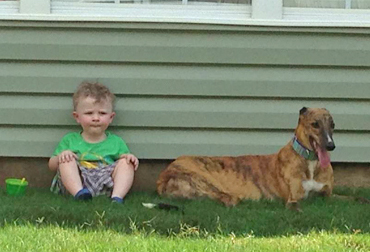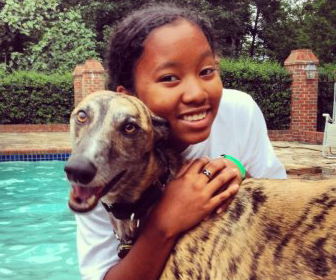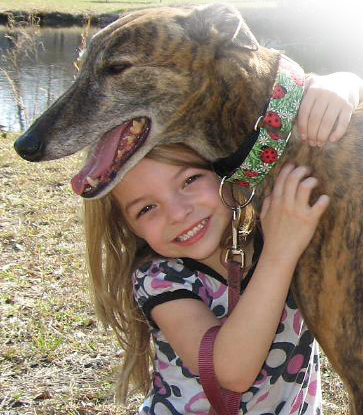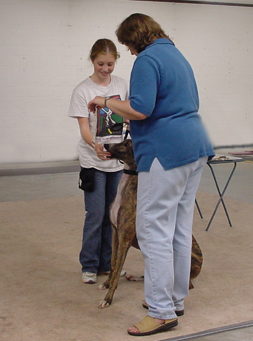Kids & Greyhounds
Kid Testing
Most greyhounds are good with well behaved kids. So how do we decide if a greyhound should live with kids?
First we look at the history of that specific greyhound. If a greyhound race trainer has children, they end up spending a lot of time with the dogs in that kennel. Those greyhounds are familiar with and respectful of kids after months or years of being handled by them. If the trainer doesn't have children, then we ask for any history of aggression with humans or even other animals. If so, we automatically mark it "no children". Just because a greyhound has shown aggression towards another dog, doesn't mean that it will be aggressive to a human at all, but we just think it is safer not to take that chance.
We have to identify what aggression towards another dog or human actually is though. We don't consider growls or snaps to be aggression. Those are a form of dog communication and don't mean that the dog will actually do harm. It usually means that the dog has chosen to growl or air snap as a warning and has chosen NOT to do harm. Dogs can snap flies out of the air, so air snaps are not "missed bites" but warnings that were never intended to harm. We consider true aggression to be when a dog actually does harm to another dog or human intentionally. As thin as greyhound skin is there are accidental injuries between two dogs when playing and those are never considered actual aggression.
We also look at the reason for the aggression. All too often aggression is triggered by a child accidentally or intentionally hurting a dog. In those cases we still choose to place the dog in a home with no children because the dog could associate kids with the bad experience. Dogs that have had bad experiences with kids deserve a child free home where they can relax.
If the dog does not have any past history of aggression, we watch the dog in its foster home to see if it has any tendancies that could cause problems with children - getting possessive over toys or space, guarding food and bones, or showing sleep startle. If a dog is very bad with these behaviors they would be marked "no children". If the dog was a little growly, but not trying to bite over items and was responding well to training we might mark them "older children only". Older children could easily learn to leave a dog alone during feeding, or not to bother a dog when it is sleeping, and to never try to take a bone or a toy away from a dog. Smaller kids would have more difficulty understanding and following those rules.
We watch the dog's energy level. Some of our dogs are marked "older children only" simply because they are big, excitable, move fast and could easily flatten a small child if they got excited. Higher energy, young greyhounds that are playful, jump on people and are clumsy are often marked "older children only" even if they really love kids.
We also watch the dog's body language around children. Does it go right up to kids in a friendly manner? Does it choose to be with children at meet and greets or does it back away nervously? Many greyhounds have never been exposed to kids at the race track. Some are very nervous of the tiny people at first, but get over that with exposure and end up loving children. Some of our very shy dogs that are afraid of fast movements and loud noises would probably always be uncomfortable in a home with loud, rowdy, small kids. They would be marked "older children only" or "no children" depending on how fearful they were around kids of different ages.
We also watch a greyhound's body language around other dogs and people. Generally the more submissive dogs are better with kids. Submissive dogs are NOT nervous dogs, they are just not dominant dogs. A couple of submissive behaviors are: kissing - trying to lick a person's lips, smiling - looks a bit like a snarl or showing teeth but is actually a submissive greeting and a true smile. Not very many greyhounds smile, but we sure like the ones that do. Low tail carriage can be submissive as long as it isn't nervously tucked. A few greyhounds have a naturally high tail carriage with a tail curled up over their back so that isn't always the case though. You really have to know what is normal for that dog.
Other body language that we watch for: Relaxed ears and a relaxed loose mouth around kids. A dog that rolls over and shows you his belly calmly for a belly rub is great, but not one that does that nervously, out of fear. Posturing-standing tall and stiff with a tense wag is not good, but there is a play gesture that is very similar that is often quickly followed by a play bow that can make that hard to judge. Tail tucked and cowering is fear and not good. We watch to see if the dog leans toward the kids or back away from them, leaning in is usually good. Ears flattened tensely and tightly against head with dilated eyes is not good but a relaxed greyhound does hold its ears pretty close to his head. A slightly open, relaxed mouth can be the key if you aren't familiar with the fine differences between relaxed and tense greyhound ears. If the mouth is relaxed and open slightly or doing a happy relaxed pant then the ears are probably in their natural relaxed position too.
Even though most greyhounds chase a bunny at the track most can easily distinguish between the toy they chased and live animals that they can't chase, which is why most can live with cats and small white fluffy dogs that look like lures. We have only run into a couple out of over a thousand that had such a high prey drive that they couldn't be around babies. We don't get many really high prey drive greyhounds, but when we do, we always err on side of caution and avoid placing them in homes with babies or tiny children. Unless they have had the opportunity to spend a lot of time with kids and we know they are absolutely fine with kids we will give them an "older children only" rating.
Something that is important for parents of small kids to know is, how they dress their child can make them a target for any breed of dog. We have seen small children with squeakers in their shoes- this turns your child into a squeaky toy in the eyes of every dog they meet. Dressing your child to look like a stuffed animal in a furry snow suit is also dangerous, if you are going to be around dogs. All dogs are predators and the last thing you want is for a dog to mistake your child for a furry toy.
Even with this extensive screening process most greyhounds pass and end up being good with kids. In studies on aggression in dogs the greyhound breed came up #33 out 33 on the aggression scale. The most aggressive breed in the study was a dachshund. Even though greyhounds don't tend to be aggressive, dogs and small children should always be supervised together. Usually more for the protection of the dog than the child. Most dog bites occur when the dog and the child are not supervised and the dog never gets to tell his side of the story.
Training Your Child
Training your child how to treat a dog properly is very important. Especially if your child is used to being around dogs and had had dogs in the home before, don't expect your new dog to enjoy or tolerate the same behaviors. Many things children naturally do to dogs can be considered threatening or even aggressive to the dog. Hugging a dog or leaning over a dog, staring into a dog's eyes, putting your face into a dog's face for a kiss or just to "love" the dog, are all aggressive moves in dog body language. If another dog did these things to your dog it could trigger a fight. Many parents encourage kids to go up and "hug" or "kiss" the dog, but it is much better to train your child to pet the dog on the chest or side and to not make direct eye contact with the dog. Never encourage your child to put their face in a dog's face. Screaming, running and fast movements can trigger a play chase and a nip in a more outgoing dog and fear in a more timid dog. Don't let your child play tug or keep away with a dog's toys. Never let a child tease a dog. Always keep children away from a dog when it is eating or chewing on a bone. Sharing food is not something most animals understand.
That old saying "Let a sleeping dog lie" is VERY important to teach children. Not following this rule probably contributes to more dog bites than any  other behavior. A dog that is sleeping or even just laying down should be left alone. For this reason, it is never a good idea to have your dog share a child's bed, no matter how cute it is. Kids move and kick in their sleep, how much of that will your dog tolerate before it snaps? Couches can also be a trouble spot. When your dog is laying on a couch sleeping and a toddler comes up to them, the child's face is right in the dog's face. A child cuddling with a dog on the couch is very cute, until your dog decides it isn't. Dogs have bad days, get aggravated by kids and can get grumpy just like parents of toddlers. It is better not to assume that the dog will always want to cuddle and teach the child to respect the dog's space. Teaching a new dog to stay off the couch or asking the dog to politely leave the couch when the family wants to sit there may be the best way to avoid this when you have small kids. Dog beds should be the dog's "safe, child-free zone" where he can go to take a break and get sleep. Children should never be allowed to bother him there. Not so difficult with babies before they are mobile, but it takes constant supervision with a toddler. With toddlers, care should also be taken to prevent them from falling on greyhounds. Little elbows and knees hurt bony dogs, that don't have much fat to protect them, and most dogs will snap when injured. Children should NEVER be allowed to climb on, lay on or ride a greyhound even if the dog seems tolerant and OK with it. A sweet, tolerant dog like a greyhound may put up with behavior they don't like for a very long time before letting anyone know that they don't like it.
other behavior. A dog that is sleeping or even just laying down should be left alone. For this reason, it is never a good idea to have your dog share a child's bed, no matter how cute it is. Kids move and kick in their sleep, how much of that will your dog tolerate before it snaps? Couches can also be a trouble spot. When your dog is laying on a couch sleeping and a toddler comes up to them, the child's face is right in the dog's face. A child cuddling with a dog on the couch is very cute, until your dog decides it isn't. Dogs have bad days, get aggravated by kids and can get grumpy just like parents of toddlers. It is better not to assume that the dog will always want to cuddle and teach the child to respect the dog's space. Teaching a new dog to stay off the couch or asking the dog to politely leave the couch when the family wants to sit there may be the best way to avoid this when you have small kids. Dog beds should be the dog's "safe, child-free zone" where he can go to take a break and get sleep. Children should never be allowed to bother him there. Not so difficult with babies before they are mobile, but it takes constant supervision with a toddler. With toddlers, care should also be taken to prevent them from falling on greyhounds. Little elbows and knees hurt bony dogs, that don't have much fat to protect them, and most dogs will snap when injured. Children should NEVER be allowed to climb on, lay on or ride a greyhound even if the dog seems tolerant and OK with it. A sweet, tolerant dog like a greyhound may put up with behavior they don't like for a very long time before letting anyone know that they don't like it.
No matter how wonderful, tolerant and non-aggressive our breed is, all dogs have limits. Most dogs will eventually growl, snap or bite, if children continue to treat them poorly, either accidentally or on purpose. Be sure you know dog body language, supervise and step in to protect your dog and give it a "safe zone" where it can get away from kids when it has had enough. Even a well behaved kid that has been taught how to behave around dogs can be annoying sometimes. If you do hear a growl or see an air snap don't assume you have an aggressive dog. Remember those are the only ways a dog has to let you or a child know that it is uncomfortable with what is happening. When it chooses to growl or air snap a warning instead of actually biting, it shows that it chose to warn rather than be aggressive.
Please use baby gates, closed doors, and kennels to keep your dog away from small children when you are busy and can't watch them. Never leave a dog unattended with a child. Remember, greyhounds are very low energy dogs that need to sleep most of the day. Make sure your dog has plenty of quiet, down-time away from children so it can sleep. Only expose your new dog to children for short times during the day and only when well supervised at first. Understand that your dog will need your protection from small visiting children as well as kids that live there.
A good article about teaching kids proper behavior around dogs.
Previous page: Separation Anxiety
Next page: Cat Testing and Introductions